Reference architecture for designing a highly available environment on VMware Cloud on AWS is now available. This technical article dives into detail about using multiple Native AWS Availability Zones for your SDDC and a 3-Tier App model to maintain service uptime for critical workloads
Do you need to design a highly available environment to meet your service uptime requirements? It’s possible to leverage multiple Native AWS Availability Zones (AZ) for a single VMware Cloud “Stretched” Software Defined Data Center (SDDC) while maintaining a “3-Tier App” environment on-premises.
This reference architecture walks you through how it’s done, providing detail of end-to-end services that can be designed when VMware Cloud on AWS is used as a second data center, instead of building a new physical location or the target location of a primary data center migration.
The “3-Tier App” model – web, application, and database tiers – is the main discussion topic during architectural workshops and the surrounding services to support a hybrid cloud solution. A number of applications within this model require a highly available environment in order to maintain service uptime for end customers. Control systems for industrial markets is one example.
As the architecture diagram shows, a single VMware Cloud on AWS SDDC is exposed to the customer even though it is stretched between two AZs for a higher Service Level Agreement (SLA). This set-up simplifies the consumption of the service due to the single instance where the compute, storage, and networking functions are also stretched across the two AZs as a part of the Managed Service.
In addition to this highly available model for VMware Cloud on AWS, associated Native AWS services can be deployed in a model that supports high availability using an Active (AZ1) / Standby (AZ2) Relational Database Service (RDS) where systems such as backend billing can be migrated. The connectivity to these types of services from the VMware Cloud on AWS and Native AWS AZs would use the Elastic Network Interface (ENI) which is also included as a part of the Managed Service. The connectivity between the Active (AZ1) / Standby (AZ2) RDS would use the local VPC Router as a part of the Native AWS environment.
During an outage of an AWS AZ, the VMware Cloud on AWS instances such as vCenter, vSAN, and NSX are automatically migrated to the other AZ and the host cluster will automatically expand to the correct capacity using the Elastic Distributed Resource Scheduler (EDRS) service. It means the customer can still consume the single VMware Cloud on AWS SDDC while the underlying platforms and services have automatically migrated – including the ENI in the active AZ.
The associated AWS instances to this type of highly available deployment model for VMware Cloud on AWS are located in the VMware Cloud Console for the Cloud Administrator. These types of items include the AWS Virtual Private Cloud (VPC) Identifier, the two active AWS Availability Zones (us-east-1a, us-east-1b), and the currently active ENI.
Looking to better understand VMware’s unique approach to multi-cloud architecture? Get the definitive guide here.




